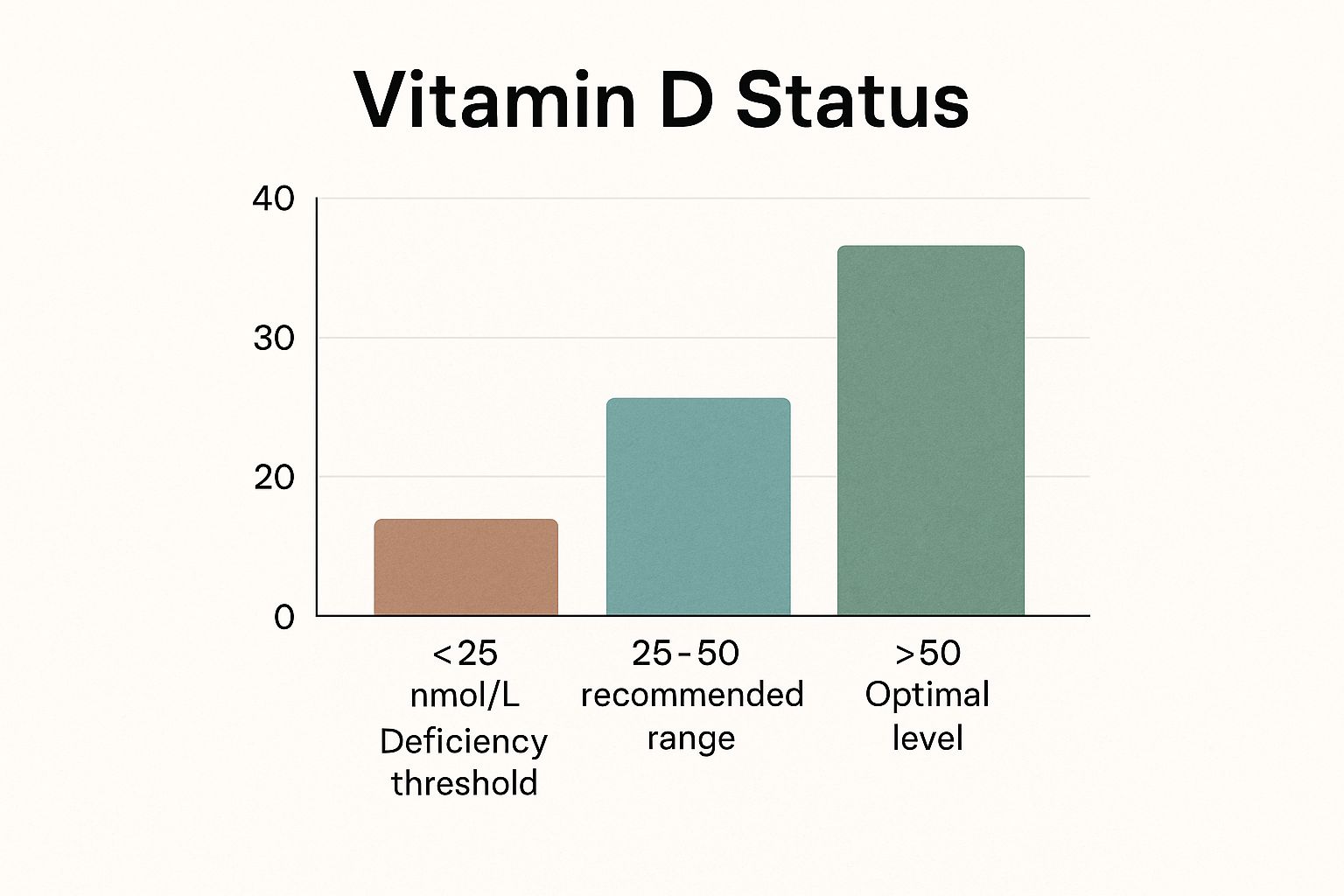When we talk about vitamin D levels in the UK, the official benchmark for "normal" is anything above 50 nmol/L (nanomoles per litre). Anything dipping below 25 nmol/L, however, is considered a deficiency—a red flag for your health today and a significant roadblock to healthy ageing. Knowing where you stand on this spectrum is the essential first step to taking control of your long-term well-being.
What's a Healthy Vitamin D Level in the UK?
Think of your vitamin D level like the foundational integrity of a building. It’s not just about passing a basic inspection; it's about having the structural strength to withstand the test of time. While official guidelines give us a baseline, just scraping by on the minimum is not a strategy for longevity. For a longer, healthier life, your goal should be to optimise, not just to avoid deficiency.
This isn’t a minor issue; vitamin D deficiency is a major public health concern here in the UK. It’s estimated to affect a staggering 1 in 6 adults and almost 20% of children, contributing to serious problems like rickets and bone pain. You can find out more about the government's review into vitamin D intake and its wider impact.
This chart breaks down the key thresholds for vitamin D, showing the journey from deficiency to optimal health.

As you can see, while simply getting above 25 nmol/L is a start, pushing into the optimal range (above 50 nmol/L) is where the real long-term benefits for cellular health and longevity are unlocked.
The Numbers and Your Longevity
If you're focused on longevity, just avoiding a deficiency is setting the bar too low. The real goal is to achieve an optimal state. This is where your body has everything it needs to function at its peak, properly manage cellular repair, and build resilience against the challenges of ageing.
"Many experts agree a minimum level somewhere between 70 and 80 nmol/L is a better target for optimal health, moving well beyond the basic 'adequate' threshold. This higher range is increasingly seen as a proactive measure for supporting long-term wellness."
So, what do these numbers actually mean for you day-to-day?
UK Vitamin D Level Guidelines at a Glance
This table breaks down the different vitamin D ranges and explains what each one means for your health in simple terms.
| Status | Level (nmol/L) | Health Implication for Longevity |
|---|---|---|
| Deficient | Below 25 nmol/L | Your body’s core systems are compromised. This accelerates wear and tear, hinders cellular repair, and weakens your defences against age-related decline. |
| Insufficient | 25–50 nmol/L | You have just enough to function, but not enough to thrive. Long-term, this suboptimal state can contribute to chronic inflammation and compromise your body’s resilience. |
| Optimal | Above 50 nmol/L | Your body is well-equipped for the long haul. This level supports robust immune function, strong cellular integrity, and provides a powerful defence against the processes of ageing. |
Ultimately, understanding your personal vitamin D level puts the power back in your hands, allowing you to fine-tune your health for a longer, more vibrant life.
The Link Between Vitamin D and Your Longevity

We often hear about vitamin D in the context of strong bones, but its real influence runs much, much deeper. It’s not just a vitamin; it’s a powerful hormone that helps direct traffic inside your body, communicating with your cells and influencing the activity of thousands of genes critical to ageing well.
Think of it as a master regulator of cellular health. Just as a skilled manager ensures a company runs efficiently for decades, vitamin D helps orchestrate countless biological processes that are essential for maintaining your body's systems as you age.
This role as a great coordinator has profound effects on your long-term health. Getting your vitamin D levels right isn't just a short-term fix; it's a proactive strategy to help your body handle the natural challenges of ageing, keeping its systems running smoothly for years to come.
How Vitamin D Supports a Longer, Healthier Life
The influence of this "master regulator" touches several core systems that directly impact not just how long you live, but how well you live. Aiming for normal vitamin D levels in the UK is less about simply avoiding a deficiency and more about giving your body the tools it needs to flourish for decades.
Here are a few key areas where vitamin D really shines:
- A Smarter Immune System: It helps your immune system strike the right balance, making it sharp enough to fight off infections but calm enough to avoid the chronic "inflammageing"—the age-related inflammation that damages tissues over time.
- Tackling Chronic Inflammation: Low-grade, persistent inflammation is a known driver of most age-related diseases. Vitamin D is a key player in keeping this damaging process under control, protecting your organs, blood vessels, and brain.
- Protecting Your Brain: Emerging research highlights a strong connection between optimal vitamin D levels and long-term brain health. It appears to play a part in protecting against age-related cognitive decline and maintaining mood stability.
By overseeing cell growth and repair, vitamin D helps maintain the very integrity of your body's fundamental building blocks. This lays the groundwork for a longer, more vibrant life.
At the end of the day, ensuring your levels are in the optimal range is one of the most practical and effective steps you can take to support your body's ability to age gracefully and stay at its best.
Who Is at Higher Risk of Vitamin D Deficiency?

While the UK’s famously grey skies don't do any of us favours, some people have a much harder time keeping their vitamin D levels up. Knowing if you fall into one of these higher-risk groups is the first step in taking proactive control of your health before a deficiency starts silently undermining your longevity goals.
The truth is, getting enough vitamin D is a national challenge. Even with a huge increase in testing over the past twenty years, around one-third of UK adults who are tested still turn out to be deficient. It’s a stubborn problem, particularly for ethnic minority communities and those from more deprived areas.
Key Risk Factors to Watch Out For
Several factors, from your biology to your lifestyle, can make it tougher for your body to produce or hold onto enough vitamin D. Seeing yourself in this list is a cue to take a closer look at your levels.
-
People with Darker Skin: Melanin, the pigment that gives skin its colour, is a fantastic natural sunblock. The downside? It also blocks the UVB rays needed to make vitamin D. This means someone with darker skin needs significantly more sun exposure to produce the same amount of vitamin D as a person with lighter skin.
-
Older Adults: Our skin’s ability to synthesise vitamin D naturally declines as we get older. On top of that, many older adults tend to spend more time indoors and may not get enough vitamin D from their diet alone, creating a perfect storm for deficiency.
-
Limited Sun Exposure: This isn't just about people who are housebound. If you work in an office, do night shifts, or cover your skin for religious or cultural reasons, you belong in this group. Without regular, direct sunlight on your skin, your body simply can’t make what it needs.
Simply put, where you live and work in the UK plays a major role. Someone living in northern Scotland will have a much shorter window for vitamin D synthesis than someone in the South East, compounding the risk for those already vulnerable.
Figuring out your personal risk is crucial. The next logical step is to get the actual data on your levels. Convenient checks, like https://lolahealth.com/blogs/longevity/at-home-health-testing, can give you the clear answers you need to start optimising your health for the long term.
How Can You Get an Accurate Vitamin D Test?

Guessing your vitamin D status is like trying to plan for retirement without knowing your bank balance. To truly take control of your long-term health, you need concrete data—a specific number that shows you exactly where you stand. The only way to get that is with an accurate blood test.
In the past, this usually meant booking an appointment with your GP. But getting a test on the NHS often involves long waits and is typically reserved for people who are already showing clear signs of deficiency. While it's still a perfectly valid option, there are now far more direct and convenient ways to get these insights.
At-home testing has completely changed the game, putting the power to monitor your health directly into your hands. It's a straightforward way to get a clear, numerical result (your nmol/L level) without all the hassle.
A Modern Way to Get Your Health Data
The whole process is designed to be simple and, most importantly, accurate. It bridges that gap between simply wondering about your health and actively managing it with real information.
Here’s how a professional at-home service works:
- Convenient Sample Collection: A trained phlebotomist comes right to your home or office to take a blood sample. This venipuncture method is the gold standard for testing, delivering a high-quality sample with a 99.8% success rate.
- Certified Lab Analysis: Your sample is sent to the very same UKAS-accredited labs the NHS uses, so you can be confident the results are reliable and precise.
- Actionable Insights: You'll receive your specific vitamin D level through a secure app, often with a doctor's review to help you understand what the numbers actually mean for you.
An accurate test is the non-negotiable starting point for any effective health strategy. It transforms your approach from reactive guesswork to proactive, data-driven management, which is fundamental for longevity.
This kind of detailed insight is crucial. For instance, learning about the full range of biomarkers measured in The Peak Insights Blood Test can show you how vitamin D fits into your broader health picture.
How to Keep Your Vitamin D Levels Healthy All Year
Getting your vitamin D levels into the optimal range—and keeping them there—is a year-round commitment to your long-term health. The best way to think about it is like a three-legged stool supporting your longevity goals. One leg is sunlight, another is your diet, and the third is supplementation. If any one of them is shaky, the whole thing can become unstable.
Your strategy has to change with the seasons. Between late March and September, getting some sensible sun is your best friend. This doesn't mean you need to sunbathe for hours; just 15-20 minutes on your arms and legs a few times a week around midday is often enough to make a real difference.
But once October rolls around, that plan goes out the window. The sun in the UK just isn't strong enough for our skin to make vitamin D. At this point, you absolutely have to lean on diet and supplements to maintain your cellular health through winter.
Using Food as Your First Line of Defence
While the sun is our main source, your diet can provide crucial backup. Foods like oily fish (think salmon and mackerel), red meat, and egg yolks naturally contain some vitamin D, though usually not enough on their own to maintain optimal levels.
That’s where fortified foods come in. To help boost the UK's vitamin D levels, many everyday items like breakfast cereals, plant-based milks, and even some yoghurts have vitamin D added to them. In fact, the National Diet and Nutrition Survey found these fortified cereals were a major reason for better vitamin D levels across the country.
Why Supplements Are So Important
For most of us in the UK, even a great diet and a sunny summer aren't quite enough to get us through the year. It's why public health advice is crystal clear: everyone should consider a daily supplement of 10 micrograms (400 IU) of vitamin D, especially from October to March. This is your most actionable tool for longevity.
It's not about taking a supplement now and then; consistency is what really matters. A daily dose stops your levels from crashing during the winter, which is crucial for supporting your immune system and keeping your cells healthy when you're most vulnerable.
For many, looking into specific Vitamin D3 supplement options is a smart move to keep levels stable.
If a test shows you're seriously deficient, your GP might prescribe a higher dose for a while to get you back into a healthy range. Once you know what your body needs, you can browse a range of nutrition and vitamin D products to create a plan that truly works for you.
Your Vitamin D Questions Answered
We’ve covered a lot of ground on what vitamin D is and why it matters. But when it comes to managing your own health for longevity, the practical, day-to-day questions are often the most important. Let's tackle some of the most common ones we hear.
Think of this as the final piece of the puzzle, moving from theory to confident, practical steps you can take for your long-term well-being.
Can I Get Enough Vitamin D From Sunlight Alone in the UK?
It’s really a tale of two seasons here in the UK. From late March to the end of September, the good news is that most of us can make enough vitamin D. All it takes is short, daily spells of sunshine on our skin – no need to sunbathe for hours on end.
Once October rolls around, though, the story changes completely. Through to early March, the sun is simply too low in the sky, and its rays aren’t strong enough for our bodies to produce any vitamin D. During these darker months, relying on sunlight just isn’t an option, making food and supplements absolutely essential for maintaining your levels.
Are Vitamin D Supplements Safe to Take Every Day?
For most people, yes – taking the recommended daily amount is not only safe but a very sensible strategy for long-term health. UK health experts suggest a daily dose of 10 micrograms (400 IU) for the average adult. This is a maintenance dose designed to keep you topped up and prevent deficiency, not to cause problems.
The real risk comes from taking massive doses for a long time without medical advice, which can lead to a dangerous build-up of calcium in your blood. It's best to stick to the recommended amount unless a blood test shows you're severely deficient and your doctor specifically tells you to take a higher dose for a short period.
"A sensible daily supplement is a safe and effective insurance policy against the long, grey UK winter. It's about consistency, not high dosage, for maintaining long-term health."
How Long Does It Take to Correct a Deficiency?
This really depends on your starting point. The time it takes to get your levels back into the optimal range is different for everyone.
- If you're just a little low: A standard daily supplement (400 IU) will often do the trick. It might take a few months of consistent use to reach the optimal zone, but this slow and steady approach is a sustainable habit for longevity.
- If you have a serious deficiency: Your doctor might recommend a short-term, high-dose treatment. This is designed to boost your levels much more quickly, and you could see a big improvement in just a few weeks.
Whatever your situation, follow-up testing is non-negotiable. It's the only way to know for sure that you’ve reached a healthy level and can switch to a maintenance plan. Without checking, you’re just guessing with a crucial biomarker for your long-term health.
Stop guessing about your health. With Lola’s at-home phlebotomy service, you can get precise, lab-accurate results for your vitamin D and other key health markers, all reviewed by a doctor. Book your test and get the clarity you need to take control of your long-term health.


